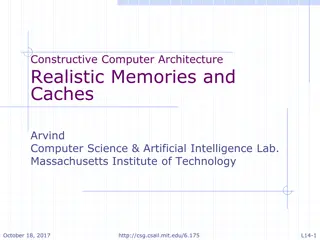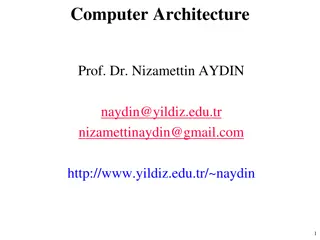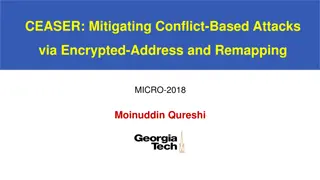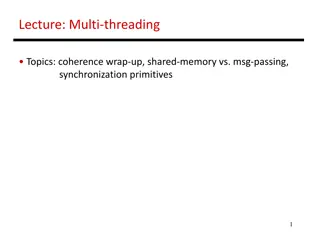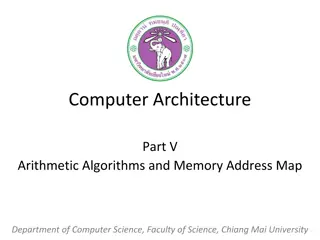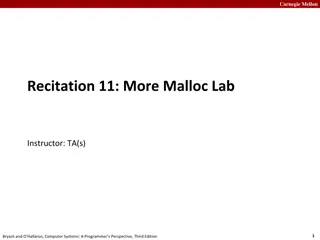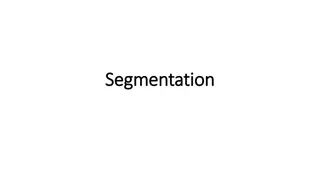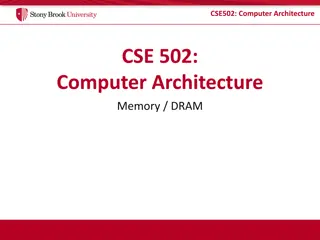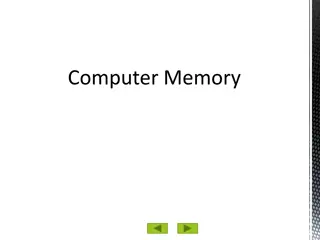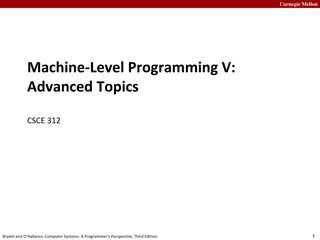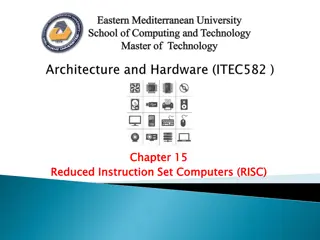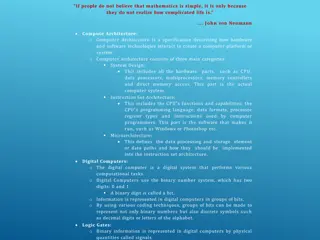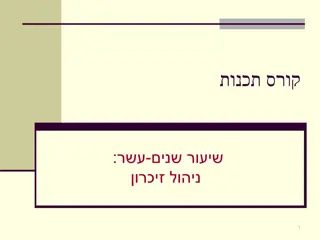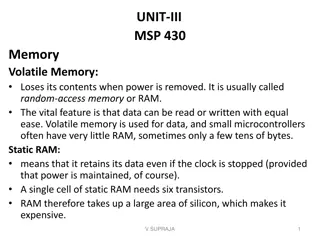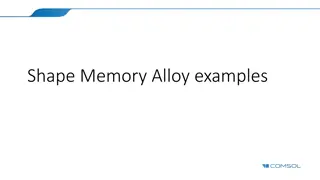Understanding Cache Memory in Computer Architecture
Cache memory is a crucial component in computer architecture that aims to accelerate memory accesses by storing frequently used data closer to the CPU. This faster access is achieved through SRAM-based cache, which offers much shorter cycle times compared to DRAM. Various cache mapping schemes are employed to facilitate efficient data retrieval and storage. Main memory and cache are divided into blocks of equal size, with the CPU utilizing specific mapping schemes to locate and access data effectively.
Download Presentation

Please find below an Image/Link to download the presentation.
The content on the website is provided AS IS for your information and personal use only. It may not be sold, licensed, or shared on other websites without obtaining consent from the author. Download presentation by click this link. If you encounter any issues during the download, it is possible that the publisher has removed the file from their server.
E N D
Presentation Transcript
Computer Architecture Lecture Seven . / / . Chapter Five\ Cache Memory /
2 What is Cache The purpose of cache is to speed up memory accesses by storing recently used data closer to the CPU, instead of storing it in main memory. Although cache is not as large as main memory, it is considerably faster. Whereas main memory is typically composed of DRAM with, say, a 60ns access time, cache is typically composed of SRAM, providing faster access with a much shorter cycle time than DRAM (a typical cache access time is 10ns). Cache is not accessed by address; it is accessed by content. For this reason, cache is sometimes called content addressable memory or CAM. Under most cache mapping schemes, the cache entries must be checked or searched to see if the value being requested is stored in cache.
3 Cache memory in a computer differs from our real-life examples in one important way: The computer really has no way to know, a priori, what data is most likely to be accessed, so it uses the locality principle and transfers an entire block from main memory into cache whenever it has to make a main memory access. The size of cache memory can vary enormously.
4 Cache Mapping Schemes for accessing data or instructions (locating the desired data), the CPU first generates a main memory address. If the data has been copied to cache, the address of the data in cache is not the same as the main memory address. How does the CPU locate data when it has been copied into cache? The CPU uses a specific mapping scheme that converts the main memory address into a cache location. This address conversion is done by giving special significance to the bits in the main memory address. We first divide the bits into distinct groups we call fields. Depending on the mapping scheme, we may have two or three fields.
5 The mapping scheme determines where the data is placed when it is originally copied into cache and also provides a method for the CPU to find previously copied data when searching cache. Main memory and cache are both divided into the same size blocks. When a memory address is generated, cache is searched first to see if the required word exists there. When the requested word is not found in cache, the entire main memory block in which the word resides is loaded into cache.
How Do We Use Fields In The Main Memory Address? 6 One field of the main memory address points us to a location in cache in which the data resides, if it is resident in cache (this is called a cache hit), or where it is to be placed if it is not resident (which is called a cache miss). The cache block referenced is then checked to see if it is valid. This is done by associating a valid bit with each cache block. A valid bit of 0 means the cache block is not valid (we have a cache miss) and we must access main memory. A valid bit of 1 means it is valid (we may have a cache hit but we need to complete one more step before we know for sure). We then compare the tag in the cache block to the tag field of our address. (The tag is a special group of bits derived from the main memory address that is stored with its corresponding block in cache.) If the tags are the same, then we have found the desired cache block (we have a cache hit). At this point we need to locate the desired word in the block; this can be done using a different portion of the main memory address called the word field.
7 Cache Mapping Schemes 1. Direct mapped cache 2. Fully associative cache 3. Set associative
Scheme 1: Direct Mapped Cache 8 Direct mapped cache assigns cache mappings using a modular approach. Because there are more main memory blocks than there are cache blocks, it should be clear that main memory blocks compete for cache locations. Direct mapping maps block X of main memory to block Y of cache, mod N, where N is the total number of blocks in cache. For example, if cache contains 10 blocks, then main memory block 0 maps to cache block 0, main memory block 1 maps to cache block 1, . . . , main memory block 9 maps to cache block 9, and main memory block 10 maps to cache block 0 (Figure ). Main memory blocks 0 and 10 (and 20, 30, and so on) all compete for cache block 0.
9 Direct Mapping of Main Memory Blocks to Cache Blocks
10 If main memory blocks 0 and 10 both map to cache block 0, how does the CPU know which block actually resides in cache block 0 at any given time? The answer is that each block is copied to cache and identified by the tag There are two valid cache blocks. Block 0 contains multiple words from main memory,identified using the tag 00000000 . Block 1 contains words identified using tag 11110101 . The other two cache blocks are not valid.
11 To perform direct mapping, the binary main memory address is partitioned into the fields The size of each field depends on the physical characteristics of main memory and cache. The word uniquely identifies a word from a specific block. This is also true of the block field it must select a unique block of cache. The tag field is whatever is left over. When a block of main memory is copied to cache, this tag is stored with the block and uniquely identifies this block.
12 Example Consider the following example: Assume memory consists of 214 words, cache has 16 blocks, and each block has 8 words. From this we determine that memory has 214 /23 = 211 blocks. We know that each main memory address requires 14 bits. Of this 14-bit address field, the rightmost 3 bits reflect the word field (we need 3 bits to uniquely identify one of 8 words in a block). We need 4 bits to select a specific block in cache, so the block field consists of the middle 4 bits. The remaining 7 bits (211/24 (16 block)= 27 (128) ) make up the tag field.
13 Suppose we have a system using direct mapping with 16 words of main memory divided into 8 blocks (so each block has 2 words). Assume the cache is 4 blocks in size (for a total of 8 words). Table 6.1 shows how the main memory blocks map to cache. A main memory address has 4 bits (because there are 24 or 16 words in main memory). This 4-bit main memory address is divided into three fields: The word field is 1 bit (we need only 1 bit to differentiate between the two words in a block); the block field is 2 bits (we have 4 blocks in main memory and need 2 bits to uniquely identify each block); and the tag field has 1 bit (this is all that is left over).
14 The main memory address is divided into the fields shown in Figure
15 Example of Direct Mapped Cache :- Suppose a program generates the address 1AA In 14-bit binary, this number is: 000001 1010 1010 The first 7 bits of this address go in the tag field, the next 4 bits go in the block field, and the final 3 bits indicate the word within the block.
16 However, if the program generates the address, 3AB 3AB also maps to block 0101, but we will not find data for 3AB in cache -Tags will not match i.e. 0000111 (of addr 3AB) is not equal to 0000011 (of addr 1AB) Hence we get it from main memory The block loaded for address 1AA would be evicted (removed) from the cache, and replaced by the blocks associated with the 3AB reference.
17 Disadvantage of Direct Mapped Cache Suppose a program generates a series of memory references such as: 1AB, 3AB, 1AB, 3AB, . . -The cache will continually evict and replace blocks The theoretical advantage offered by the cache is lost in this extreme case Other cache mapping schemes are designed to prevent this kind of thrashing
18 Calculating Cache Size Suppose our memory consists of 214 locations (or words), and cache has 16 = 24 blocks, and each block holds 8 words There are 16 locations in the cache Each row has 7 bits for tag + 8 words + 1 valid bit Assume 1 word is 8 bits, the total bits in row (8 x 8) + 7 + 1 = 72 72 bits = 9 bytes Cache size = 16 x 9 bytes = 144 bytes
Scheme 2: 19 Fully Associative Cache Instead of placing memory blocks in specific cache locations based on memory address, we could allow a block to go anywhere in cache This way, cache would have to fill up before any blocks are evicted This is how fully associative cache works A memory address is partitioned into only two fields: the tag and the word









